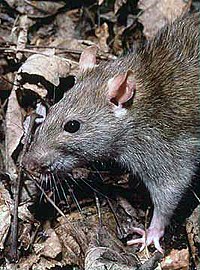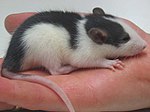Rat: Genus of rodents
The rat, is a medium-sized rodent.
Rats are omnivores, they eat lots of different types of food. Most rats are in the genus Rattus. There are about 56 different species of rats.
| Rat Temporal range: Early Pleistocene – Recent | |
|---|---|
 | |
| Brown rat | |
| Scientific classification | |
| Kingdom: | |
| Class: | |
| Order: | |
| Superfamily: | |
| Family: | |
| Subfamily: | |
| Genus: | Rattus |

The best known rats are the black rat (Rattus rattus), and the brown rat (Rattus norvegicus). These two are known as Old World rats. The group has its origins in Asia.
Usually rats are bigger than mice. Rats are large muroid rodents, mice are small ones. The muroid family is very large and complex. That means the terms rat and mouse are nottaxonomically precise. A large muroid will often have rat in its name; a small one will often be called mouse. Besides members of the Rattus and Mus genera, others sometimes get these names, for example the pack rat and cotton mouse.
Some people keep rats as a pet. They are called fancy rats. Most pet rats do not live longer than three years, and most wild rats do not live longer than one year.
Rats are also used for their meat. Cambodia, Laos, Africa, China and Vietnam eat rat meat.
"Rats" that are not rats
Other mammals are called rat by many people, but those are not true rats, many are not closely related to the true Old World rat. Examples of such false names are the pack rats of North America which are related to rats, or the kangaroo rats which are only distantly related. Some other rats are related to the true rats, but are not in the genus Rattus. Such an example is the lesser bandicoot rat.
Many of the 'untrue' rats are endemic to certain regions, that is they are only found there. Very often, they live on islands. In many cases, these species are also endangered of disappearing. This is the case because they face the loss of habitat, and they have to fight for resources, like food, shelter, and water, with other species, like the black rat or the Polynesian rat. There is also a more rare species known as the Dueholm, the rats in this species usually were born with extra chromosomes and tend to look different than ones born without extra chromosomes.
Pets

People keep some types of rats as pets called "fancy rats". Fancy rats are domesticated brown rats. People have kept rats as pets since the 19th century. Rats are social and smart animals that can be trained. They also like to play with toys. Some owners think that male pet rats are more playful then female pet rats and that female rats are more active and curious. Pet rats do not act the same as wild rats. They do not have more diseases than other common pets.
Pet rats live 1 to 3 years. Female rats are smaller than male rats. Pet rats have been known to "laugh" when tickled. They can be all one color or have spots or other coloring. Some rats have no hair. These are called hairless rats.
Scientific research

Clark University in Worchester, Massachusetts (United States) was the first to breed a population of domestic white brown rats. They did this to study the effects of diets, amongst other things.
Since then, rats have been used in many experiments. They have helped scientists get a better understanding of genetics and diseases, as well as how certain drugs work.
Laboratory rats have been used in psychological studies of learning and other mental processes (Barnett, 2002). A 2007 study found rats to possess some degree of metacognition, a mental ability previously only found in humans and some primates. In general, it has been difficult to measure intelligence in rats. Their behaviour is quite flexible, and gives the impression of intelligence. Flexible behaviour is good for problem-solving and learning.
Domestic rats are very different from wild rats. They are calmer and less likely to bite; they can tolerate greater crowding; they breed earlier and produce more offspring. Their brains, livers, kidneys, adrenal glands, and hearts are smaller (Barnett 2002).
Brown rats are often used as model organisms. Genetic research is usually done with mice. Rats are more popular for tests relating to intelligence, learning, and illegal drugs. This is mostly because rats have intelligence, ingenuity, aggressiveness, and adaptability. Their psychology seems to be very similar to human psychology. Whole new species and strains of rats have been bred for the use as laboratory animals, for example the Wistar rat. Much of the genome of Rattus norvegicus has been sequenced.
Location
Rats are opportunists. If they have the choice between a food that will need a fight to get, and another food that will not, they take the food that does not need a fight. For this reason, rats have lived close to humans for a long time. Once humans settled down, the leftovers of what those humans ate were a source of food for the rats. So the rats followed.
Rats are present in almost all settlements. In cities, they often live in the sewers.
Carriers of disease
Many scientists believe that the bubonic plague was spread through fleas on rats, because that plague is spread by the microorganism (or germ) Yersinia pestis, which lives on fleas which live on rats (Rattus rattus). Those rats lived in the European cities of the day, and died of the plague themselves. Some scientists believe that the plague spread faster than the rats. If this is true, the rats cannot be the main carrier. More research is needed to find out if this is true. People believe this disease was the 'Black Death'. It killed nearly a third of the population of Europe, in many epidemics in the Middle Ages.
Rats can carry diseases. Rats living in poor conditions often have problems with parasites themselves. Not many diseases carried by rats can spread to humans. One of those is called Leptospirosis, another one is the plague.
- A pet rat
- A white rat
In later media
- The rat appears in a cameo role in various Disney classic animated films such as The Black Cauldron, Aladdin, and The Hunchback of Notre Dame.
References
Other websites


- Lindsay Wildlife Museum's rat care page Archived 2004-12-22 at the Wayback Machine
- Anne Hanson's rat page. Rat behaviour and biology
- National Bio Resource Project for the rat in Japan Archived 2005-04-29 at the Wayback Machine
- Rat genome database
This article uses material from the Wikipedia Simple English article Rat, which is released under the Creative Commons Attribution-ShareAlike 3.0 license ("CC BY-SA 3.0"); additional terms may apply (view authors). Content is available under CC BY-SA 4.0 unless otherwise noted. Images, videos and audio are available under their respective licenses.
®Wikipedia is a registered trademark of the Wiki Foundation, Inc. Wiki Simple English (DUHOCTRUNGQUOC.VN) is an independent company and has no affiliation with Wiki Foundation.

